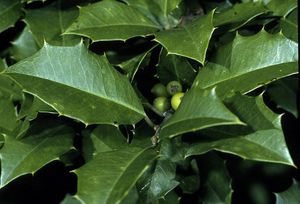The State tree of Delaware is the American Holly (Ilex opaca). The American holly is also knows as the dune holly, hummock holly, and scrub holly. This evergreen tree (or shrub) is found growing in the wild from Maine to Florida and inland to Ohio and Texas. It is hardy in Zones 5B through 9.
A mature tree can reach a height of 50 feet and a spread of 15-25 feet. The tree can grow 12-18 inches per year. If left untrimmed, the overall shape can be round or pyramidal. White flowers mature to become the berries. The tree prefers moist, acidic, well-drained soil. The American holly will tolerate sandy soil but is susceptible to flooding.
The holly is ornamental with shiny green leaves and bright red berries. The wood is harvested for the production of veneers, cabinets, handles, and scientific instruments. This evergreen tree is sometimes used on musical instruments in place of ebony.
The American holly is known in US history as a source of ornamentation. Early people fashioned the dried berries into buttons. The dried berries were also a trade item.
The American holly is widely planted as an ornamental. This evergreen tree is appropriate in shrub borders, as a hedge, and a in mass in larger landscape areas such as parks and along streets. The American holly is seen planted in the median strip along highways. The tree is also a good selection as a buffer around parking lots. American holly is sometimes used in bonsai.
In the wild, this evergreen tree is sometimes considered invasive and there are ongoing programs to reduce its coverage area. Other locations, including Delaware, passed laws to protect the holly from human predators who clipped branches from hollies growing in the wild to use as holiday decorations. The American holly is also a protected plant species in Pennsylvania and New York.
The berries are eaten by birds including songbirds, mourning doves, wild turkeys, and bobwhite. Dense growths are nesting sites for the red-cockaded woodpecker which is an endangered species.
Hollies should be planted in an area protected from strong winds. The American holly prefers full sun but will tolerate partial shade. Plant one male tree for every three female trees to ensure pollination. The lower branches can be removed to create more of a tree form which increases the versatility of the holly for use in smaller landscapes.
There are many cultivars of the American holly with variations in green coloration, leaf shape, size of the berry, and quantity of berries. Some cultivars are especially suitable to warmer Southern climates.
The berries are mildly toxic to humans if eaten in a large enough quantity. They can cause nausea, vomiting, and diarrhea. Medical attention is necessary if symptoms occur.
The American holly is particularly resistant to salt spray along ocean coasts. There are no persistent threats from pests.
Sources
Ilex opaca, USDA Forest Service, http://www.fs.fed.us/database/feis/plants/tree/ileopa/all.html
Ilex opaca, USDA Natural Resources Conservation Service, http://plants.usda.gov/java/profile?symbol=ILOP
Ilex opaca, Michigan State University Extension, http://web1.msue.msu.edu/imp/modzz/00000764.html
Ilex opaca, University of Florida, http://hort.ufl.edu/trees/ILEOPAA.pdf
Poisonous Plants, North Carolina State University, http://www.ces.ncsu.edu/depts/hort/consumer/poison/Ilex_op.htm



